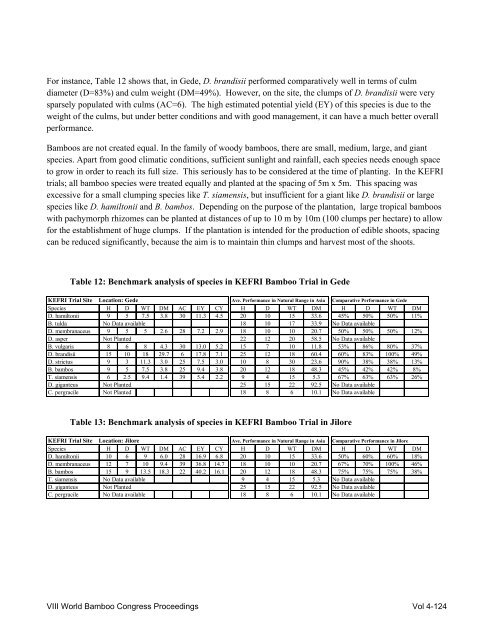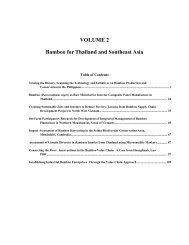WBC-VIII-Vol.4 – Resources – Forestry, Plantations and ... - BambuSC
WBC-VIII-Vol.4 – Resources – Forestry, Plantations and ... - BambuSC
WBC-VIII-Vol.4 – Resources – Forestry, Plantations and ... - BambuSC
You also want an ePaper? Increase the reach of your titles
YUMPU automatically turns print PDFs into web optimized ePapers that Google loves.
For instance, Table 12 shows that, in Gede, D. br<strong>and</strong>isii performed comparatively well in terms of culm<br />
diameter (D=83%) <strong>and</strong> culm weight (DM=49%). However, on the site, the clumps of D. br<strong>and</strong>isii were very<br />
sparsely populated with culms (AC=6). The high estimated potential yield (EY) of this species is due to the<br />
weight of the culms, but under better conditions <strong>and</strong> with good management, it can have a much better overall<br />
performance.<br />
Bamboos are not created equal. In the family of woody bamboos, there are small, medium, large, <strong>and</strong> giant<br />
species. Apart from good climatic conditions, sufficient sunlight <strong>and</strong> rainfall, each species needs enough space<br />
to grow in order to reach its full size. This seriously has to be considered at the time of planting. In the KEFRI<br />
trials; all bamboo species were treated equally <strong>and</strong> planted at the spacing of 5m x 5m. This spacing was<br />
excessive for a small clumping species like T. siamensis, but insufficient for a giant like D. br<strong>and</strong>isii or large<br />
species like D. hamiltonii <strong>and</strong> B. bambos. Depending on the purpose of the plantation, large tropical bamboos<br />
with pachymorph rhizomes can be planted at distances of up to 10 m by 10m (100 clumps per hectare) to allow<br />
for the establishment of huge clumps. If the plantation is intended for the production of edible shoots, spacing<br />
can be reduced significantly, because the aim is to maintain thin clumps <strong>and</strong> harvest most of the shoots.<br />
Table 12: Benchmark analysis of species in KEFRI Bamboo Trial in Gede<br />
KEFRI Trial Site Location: Gede Ave. Performance in Natural Range in Asia Comparative Performance in Gede<br />
Species H D WT DM AC EY CY H D WT DM H D WT DM<br />
D. hamiltonii 9 5 7.5 3.8 30 11.3 4.5 20 10 15 33.6 45% 50% 50% 11%<br />
B. tulda No Data available 18 10 17 33.9 No Data available<br />
D. membranaceus 9 5 5 2.6 28 7.2 2.9 18 10 10 20.7 50% 50% 50% 12%<br />
D. asper Not Planted 22 12 20 58.5 No Data available<br />
B. vulgaris 8 6 8 4.3 30 13.0 5.2 15 7 10 11.8 53% 86% 80% 37%<br />
D. br<strong>and</strong>isii 15 10 18 29.7 6 17.8 7.1 25 12 18 60.4 60% 83% 100% 49%<br />
D. strictus 9 3 11.3 3.0 25 7.5 3.0 10 8 30 23.6 90% 38% 38% 13%<br />
B. bambos 9 5 7.5 3.8 25 9.4 3.8 20 12 18 48.3 45% 42% 42% 8%<br />
T. siamensis 6 2.5 9.4 1.4 39 5.4 2.2 9 4 15 5.3 67% 63% 63% 26%<br />
D. giganteus Not Planted 25 15 22 92.5 No Data available<br />
C. pergracile Not Planted 18 8 6 10.1 No Data available<br />
Table 13: Benchmark analysis of species in KEFRI Bamboo Trial in Jilore<br />
KEFRI Trial Site Location: Jilore Ave. Performance in Natural Range in Asia Comparative Performance in Jilore<br />
Species H D WT DM AC EY CY H D WT DM H D WT DM<br />
D. hamiltonii 10 6 9 6.0 28 16.9 6.8 20 10 15 33.6 50% 60% 60% 18%<br />
D. membranaceus 12 7 10 9.4 39 36.8 14.7 18 10 10 20.7 67% 70% 100% 46%<br />
B. bambos 15 9 13.5 18.3 22 40.2 16.1 20 12 18 48.3 75% 75% 75% 38%<br />
T. siamensis No Data available 9 4 15 5.3 No Data available<br />
D. giganteus Not Planted 25 15 22 92.5 No Data available<br />
C. pergracile No Data available 18 8 6 10.1 No Data available<br />
<strong>VIII</strong> World Bamboo Congress Proceedings Vol 4-124




